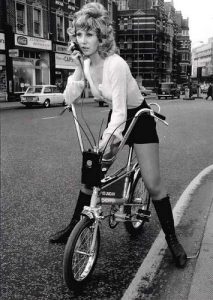
If there ever was an enduring cultural icon of the 1970s it was the Raleigh Chopper bicycle. For kids of a certain age, it was necessary to be the proud owner either of a racing bike, or of a Chopper. One was practical, fast and, when ridden correctly, relatively safe. The other was the coolest bike ever to grace the roads of Great Britain.
For those of us who opted for cool, our bicycle was less a means of conveyance than a statement. It was a motorcycle without the engine. Nobody who ever rode a Chopper didn’t imagine himself astride a roaring Triumph or a majestic Harley Davidson with ape hangers, or a buckhorn handlebar at the very least. We were Hell’s Angels in school uniform, riding out into the sunset on a paper round.
This was the age of Evel Knievel, and whilst a ride around town on a Chopper didn’t much compare in the danger stakes with a ramp-to-ramp motorcycle leap over a fleet of double decker buses, it featured enough integrated hazards to warrant a health and safety department all of its own. The long, padded saddle invited the carrying of passengers which could only help exacerbate the tendency the bike already had to tip backwards if the weight upon it wasn’t correctly distributed. This particular peril was enhanced on the earlier models by the provision of a back rest. And its protruding gearstick, situated in front of the saddle, had the potential to end marriages long before they had even been contemplated. But we loved it, and one look at its sleek design leaves one in little doubt as to why it was so popular.
Chunky tyres and three gears
In actual fact the Raleigh Chopper was patented in the 1960s, first in the US (despite it being a British bike) and only later in the UK. It went onto the market in both countries in 1969, but really came into its own in the early seventies.
With an unusually small front wheel and a larger rear wheel with a wide chunky tyre sporting deep tread, it was a fairly unique concept in bicycle design (although to some extent it had been modelled on the slightly earlier Schwinn Stingray). Unusually for a non-racing bike back in the day, it had three gears. The original (Mk. 1) version included adjustable handlebars which could be swung back to make it look even more like a drag bike, although this possibly hazardous oversight was ironed out with the Mk. 2 model in 1972. Amongst other things it featured a bike stand which was purposely positioned so as imitate the stance of a stationary motorcycle. For those whose parents had the best jobs, there was a 5-gear version which cost a whole fiver more.
A product of its time
Sadly, like all fads the dominance of the Chopper was always destined to come to an end one day. In this case it was the emergence of the BMX cycle in the early 1980s which did for it. By the time the new decade had been ushered in the only examples of the iconic 1970s cycle still to be seen on the streets were ageing ones, often hand-painted by their owners in unique and imaginative colour schemes.
There was, in the early 21st century, an attempt to revive the Chopper. Needless to say the Mark 3 version was suitably sanitised in accordance with the spirit of the new age, the gearstick being relocated to the handlebar and the long saddle, a thing of legend and of fame, being replaced by a conventional one.
The Raleigh Chopper was very much a product of its time – ostentatious, daring, although strictly speaking not overly sensible. But it was every bit as much a feature of life in the 1970s as loon pants and Top Of The Pops. Those who were there, will know.

If you enjoyed reading this article, make sure you stay updated with all Phil’s latest blog posts by signing up to receive his free Newsletter. You can unsubscribe at any time and your details will never be shared with any third party. Click here to sign up today.